mirror of
https://github.com/KusakabeShi/EtherGuard-VPN.git
synced 2024-10-07 10:21:57 +02:00
491 lines
17 KiB
Markdown
491 lines
17 KiB
Markdown
# Etherguard
|
||
[中文版](README_zh.md)
|
||
|
||
This is the documentation of the super_mode of this example_config
|
||
Before reading this, I'd like to suggest you read the [static mode](../static_mode/README.md) first.
|
||
|
||
## Super mode
|
||
|
||
Super mode are inspired by [n2n](https://github.com/ntop/n2n)
|
||
We have two types of node, we called it super node and edge node.
|
||
|
||
All edge nodes have to connect to super node, exchange data and UDP hole punch each other by super node.
|
||
The super node runs the [Floyd-Warshall Algorithm](https://en.wikipedia.org/wiki/Floyd–Warshall_algorithm), and distribute the result to all edge node.
|
||
|
||
In the super mode of the edge node, the `nexthoptable` and `peers` section are useless. All infos are download from super node.
|
||
Meanwhile, super node will generate pre shared key for inter-edge communication(if `usepskforinteredge` enabled).
|
||
```golang
|
||
psk = shs256("PubkeyPeerA" + "PubkeyPeerB" + "Chef Special and Featured in the season see salt")[:32]
|
||
```
|
||
|
||
### SuperMsg
|
||
There are new type of DstID called `SuperMsg`(65534). All packets sends to and receive from super node are using this packet type.
|
||
This packet will not send to any other edge node, just like `DstID == self.NodeID`
|
||
|
||
## Control Message
|
||
In Super mode, Beside `Normal Packet`. We introduce a new packet type called `Control Message`. In Super mode, we will not relay any control message. We just receive or send it to target directly.
|
||
We list all the control message we use in the super mode below.
|
||
|
||
### Register
|
||
This control message works like this picture:
|
||
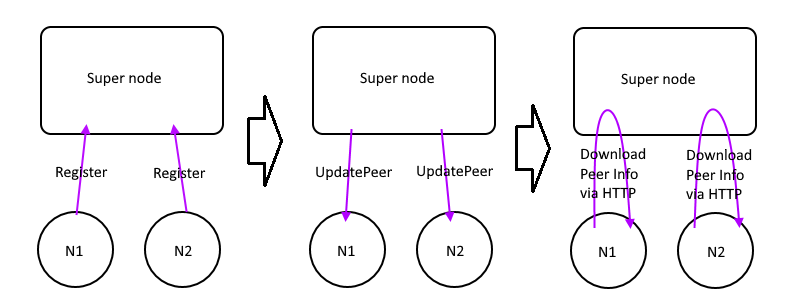
|
||
|
||
1. edge node send Register to the super node
|
||
2. Supernode knows it's external IP and port number
|
||
3. Update it to database and distribute `UpdatePeerMsg` to all edges
|
||
4. Other edges get the notification, download the updated peer infos from supernode via HTTP API
|
||
|
||
### Ping/Pong
|
||
While edges get the peer infos, edges will start trying to talk each other directly like this picture:
|
||
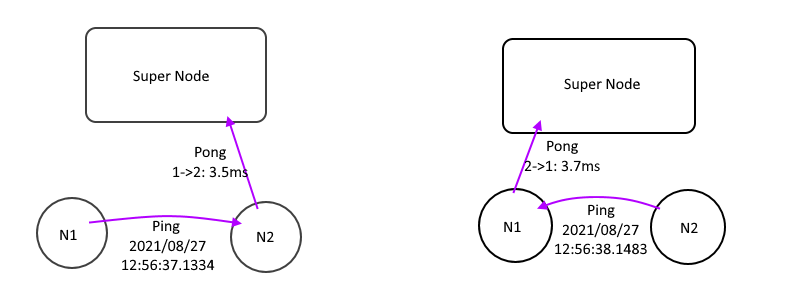
|
||
|
||
1. Send `Ping` to all other edges with local time with TTL=0
|
||
2. Received a `Ping`, Subtract the peer time from local time, we get a single way latency.
|
||
3. Send a `Pong` to supernode, let supernode calculate the NextHopTable
|
||
4. Wait the supernode push `UpdateNhTable` message and download it.
|
||
|
||
### UpdateNhTable
|
||
While supernode get a `Pong` message, it will run the [Floyd-Warshall Algorithm](https://en.wikipedia.org/wiki/Floyd–Warshall_algorithm) to calculate the NextHopTable
|
||
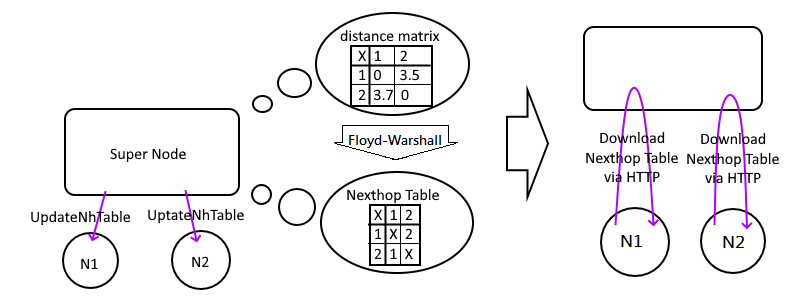
|
||
If there are any changes of this table, it will distribute `UpdateNhTable` to all edges to till then download the latest NextHopTable via HTTP API as soon as possible.
|
||
|
||
### UpdateError
|
||
Notify edges that an error has occurred, and close the edge
|
||
It occurs when the version number is not match with supernode, or the NodeID of the edge is configured incorrectly, or the edge is deleted.
|
||
|
||
### HTTP API
|
||
Why we use HTTP API instead of pack all information in the `UpdateXXX`?
|
||
Because UDP is an unreliable protocol, there is an limit on the amount of content that can be carried.
|
||
But the peer list contains all the peer information, the length is not fixed, it may exceed
|
||
So we use `UpdateXXX` to tell we have a update, please download the latest information from supernode via HTTP API as soon as possible.
|
||
And `UpdateXXX` itself is not reliable, maybe it didn't reach the edge node at all.
|
||
So the information of `UpdateXXX` carries the `state hash`. Bring it when with HTTP API. When the super node receives the HTTP API and sees the `state hash`, it knows that the edge node has received the `UpdateXXX`.
|
||
Otherwise, it will send `UpdateXXX` to the node again after few seconds.
|
||
|
||
## HTTP Guest API
|
||
HTTP also has some APIs for the front-end to help manage the entire network
|
||
|
||
### peerstate
|
||
|
||
```bash
|
||
curl "http://127.0.0.1:3000/api/peerstate?Password=passwd"
|
||
```
|
||
It can show some information such as single way latency or last seen time.
|
||
We can visualize it by Force-directed graph drawing.
|
||
|
||
There is an `Infinity` section in the json response. It should be 9999. It means infinity if the number larger than it.
|
||
Cuz json can't present infinity so that I use this trick.
|
||
While we see the latency larger than this, we doesn't need to draw lines in this two nodes.
|
||
|
||
Example return value:
|
||
```json
|
||
{
|
||
"PeerInfo": {
|
||
"1": {
|
||
"Name": "hk",
|
||
"LastSeen": "2021-09-29 11:23:22.854700559 +0000 UTC m=+28740.116476977"
|
||
},
|
||
"1001": {
|
||
"Name": "relay_kr",
|
||
"LastSeen": "2021-09-29 11:23:21.277417897 +0000 UTC m=+28738.539194315"
|
||
},
|
||
"121": {
|
||
"Name": "za_north",
|
||
"LastSeen": "0001-01-01 00:00:00 +0000 UTC"
|
||
},
|
||
"33": {
|
||
"Name": "us_west",
|
||
"LastSeen": "2021-09-29 11:23:13.257033252 +0000 UTC m=+28730.518809670"
|
||
},
|
||
"49": {
|
||
"Name": "us_east",
|
||
"LastSeen": "2021-09-29 11:23:16.606165241 +0000 UTC m=+28733.867941659"
|
||
},
|
||
"51": {
|
||
"Name": "ca_central",
|
||
"LastSeen": "0001-01-01 00:00:00 +0000 UTC"
|
||
},
|
||
"65": {
|
||
"Name": "fr",
|
||
"LastSeen": "2021-09-29 11:23:19.4084596 +0000 UTC m=+28736.670236018"
|
||
},
|
||
"81": {
|
||
"Name": "au_central",
|
||
"LastSeen": "0001-01-01 00:00:00 +0000 UTC"
|
||
},
|
||
"89": {
|
||
"Name": "uae_north",
|
||
"LastSeen": "0001-01-01 00:00:00 +0000 UTC"
|
||
},
|
||
"9": {
|
||
"Name": "jp_east",
|
||
"LastSeen": "2021-09-29 11:23:16.669505147 +0000 UTC m=+28733.931281565"
|
||
},
|
||
"97": {
|
||
"Name": "br_south",
|
||
"LastSeen": "0001-01-01 00:00:00 +0000 UTC"
|
||
}
|
||
},
|
||
"Infinity": 99999,
|
||
"Edges": {
|
||
"1": {
|
||
"1001": 0.033121187,
|
||
"33": 0.075653164,
|
||
"49": 0.100471502,
|
||
"65": 0.065714769,
|
||
"9": 0.022864241
|
||
},
|
||
"1001": {
|
||
"1": 0.018561948,
|
||
"33": 0.064077348,
|
||
"49": 0.094459818,
|
||
"65": 0.079481599,
|
||
"9": 0.011163433
|
||
},
|
||
"33": {
|
||
"1": 0.075263428,
|
||
"1001": 0.070029457,
|
||
"49": 0.032631349,
|
||
"65": 0.045575061,
|
||
"9": 0.050444255
|
||
},
|
||
"49": {
|
||
"1": 0.100271358,
|
||
"1001": 0.100182834,
|
||
"33": 0.034563118,
|
||
"65": 0.017950046,
|
||
"9": 0.07510982
|
||
},
|
||
"65": {
|
||
"1": 0.114219741,
|
||
"1001": 0.132759205,
|
||
"33": 0.095265063,
|
||
"49": 0.067413235,
|
||
"9": 0.127562362
|
||
},
|
||
"9": {
|
||
"1": 0.026909699,
|
||
"1001": 0.022555855,
|
||
"33": 0.056469043,
|
||
"49": 0.090400723,
|
||
"65": 0.08525314
|
||
}
|
||
},
|
||
"NhTable": {
|
||
"1": {
|
||
"1001": 1001,
|
||
"33": 33,
|
||
"49": 49,
|
||
"65": 65,
|
||
"9": 9
|
||
},
|
||
"1001": {
|
||
"1": 1,
|
||
"33": 33,
|
||
"49": 49,
|
||
"65": 65,
|
||
"9": 9
|
||
},
|
||
"33": {
|
||
"1": 1,
|
||
"1001": 1001,
|
||
"49": 49,
|
||
"65": 65,
|
||
"9": 9
|
||
},
|
||
"49": {
|
||
"1": 1,
|
||
"1001": 9,
|
||
"33": 33,
|
||
"65": 65,
|
||
"9": 9
|
||
},
|
||
"65": {
|
||
"1": 1,
|
||
"1001": 1001,
|
||
"33": 33,
|
||
"49": 49,
|
||
"9": 9
|
||
},
|
||
"9": {
|
||
"1": 1,
|
||
"1001": 1001,
|
||
"33": 33,
|
||
"49": 33,
|
||
"65": 65
|
||
}
|
||
},
|
||
"Dist": {
|
||
"1": {
|
||
"1": 0,
|
||
"1001": 0.033121187,
|
||
"33": 0.075119328,
|
||
"49": 0.102236885,
|
||
"65": 0.074688856,
|
||
"9": 0.022473723
|
||
},
|
||
"1001": {
|
||
"1": 0.018561948,
|
||
"1001": 0,
|
||
"33": 0.064077348,
|
||
"49": 0.094459818,
|
||
"65": 0.079481599,
|
||
"9": 0.011163433
|
||
},
|
||
"33": {
|
||
"1": 0.075263428,
|
||
"1001": 0.070029457,
|
||
"33": 0,
|
||
"49": 0.032631349,
|
||
"65": 0.045575061,
|
||
"9": 0.050444255
|
||
},
|
||
"49": {
|
||
"1": 0.100271358,
|
||
"1001": 0.097665675,
|
||
"33": 0.034563118,
|
||
"49": 0,
|
||
"65": 0.017950046,
|
||
"9": 0.07510982
|
||
},
|
||
"65": {
|
||
"1": 0.114219741,
|
||
"1001": 0.132759205,
|
||
"33": 0.095265063,
|
||
"49": 0.067413235,
|
||
"65": 0,
|
||
"9": 0.127562362
|
||
},
|
||
"9": {
|
||
"1": 0.026909699,
|
||
"1001": 0.022555855,
|
||
"33": 0.056469043,
|
||
"49": 0.089100392,
|
||
"65": 0.08525314,
|
||
"9": 0
|
||
}
|
||
}
|
||
}
|
||
```
|
||
|
||
Section meaning:
|
||
1. PeerInfo: NodeID,Name,LastSeen
|
||
2. Edges: The **Single way latency**,9999 or missing means unreachable(UDP hole punching failed)
|
||
3. NhTable: Calculate result.
|
||
4. Dist: The latency of **packet through Etherguard**
|
||
|
||
### peeradd
|
||
We can add new edges with this API without restart the supernode
|
||
|
||
Exanple:
|
||
```
|
||
curl -X POST "http://127.0.0.1:3000/api/peer/add?Password=passwd_addpeer" \
|
||
-H "Content-Type: application/x-www-form-urlencoded" \
|
||
-d "nodeid=100&name=Node_100&additionalcost=1000&pubkey=6SuqwPH9pxGigtZDNp3PABZYfSEzDaBSwuThsUUAcyM="
|
||
```
|
||
|
||
Parameter:
|
||
1. URL query: Password: Password. Configured in the config file.
|
||
1. Post body:
|
||
1. nodeid: Node ID
|
||
1. pubkey: Public Key
|
||
1. pskey: Pre shared Key
|
||
1. additionalcost: Additional cost for packet transfer. Unit: ms
|
||
1. nexthoptable: If the `graphrecalculatesetting` of your super node is in static mode, you need to provide a new `NextHopTable` in json format in this parameter.
|
||
|
||
Return value:
|
||
1. http code != 200: Error reason
|
||
2. http code == 200,An example edge config.
|
||
* generate by contents in `edgetemplate` with custom data (nodeid/name/pubkey)
|
||
* Convenient for users to copy and paste
|
||
|
||
```yaml
|
||
interface:
|
||
itype: stdio
|
||
name: tap1
|
||
vppifaceid: 1
|
||
vppbridgeid: 4242
|
||
macaddrprefix: AA:BB:CC:DD
|
||
mtu: 1416
|
||
recvaddr: 127.0.0.1:4001
|
||
sendaddr: 127.0.0.1:5001
|
||
l2headermode: kbdbg
|
||
nodeid: 100
|
||
nodename: Node_100
|
||
defaultttl: 200
|
||
privkey: Your_Private_Key
|
||
listenport: 3001
|
||
loglevel:
|
||
loglevel: normal
|
||
logtransit: true
|
||
logcontrol: true
|
||
lognormal: true
|
||
logntp: true
|
||
dynamicroute:
|
||
sendpinginterval: 16
|
||
peeralivetimeout: 30
|
||
dupchecktimeout: 40
|
||
conntimeout: 30
|
||
connnexttry: 5
|
||
savenewpeers: true
|
||
supernode:
|
||
usesupernode: true
|
||
pskey: ""
|
||
connurlv4: 127.0.0.1:3000
|
||
pubkeyv4: LJ8KKacUcIoACTGB/9Ed9w0osrJ3WWeelzpL2u4oUic=
|
||
connurlv6: ""
|
||
pubkeyv6: HCfL6YJtpJEGHTlJ2LgVXIWKB/K95P57LHTJ42ZG8VI=
|
||
apiurl: http://127.0.0.1:3000/api
|
||
supernodeinfotimeout: 50
|
||
p2p:
|
||
usep2p: false
|
||
sendpeerinterval: 20
|
||
graphrecalculatesetting:
|
||
jittertolerance: 20
|
||
jittertolerancemultiplier: 1.1
|
||
nodereporttimeout: 40
|
||
recalculatecooldown: 5
|
||
ntpconfig:
|
||
usentp: true
|
||
maxserveruse: 8
|
||
synctimeinterval: 3600
|
||
ntptimeout: 3
|
||
servers:
|
||
- time.google.com
|
||
- time1.google.com
|
||
- time2.google.com
|
||
- time3.google.com
|
||
- time4.google.com
|
||
- time1.facebook.com
|
||
- time2.facebook.com
|
||
- time3.facebook.com
|
||
- time4.facebook.com
|
||
- time5.facebook.com
|
||
- time.cloudflare.com
|
||
- time.apple.com
|
||
- time.asia.apple.com
|
||
- time.euro.apple.com
|
||
- time.windows.com
|
||
nexthoptable: {}
|
||
resetconninterval: 86400
|
||
peers: []
|
||
```
|
||
|
||
### peerdel
|
||
Delete peer
|
||
|
||
There are two deletion modes, namely password deletion and private key deletion.
|
||
Designed to be used by administrators, or for people who join the network and want to leave the network.
|
||
|
||
Use Password to delete any node. Take the newly added node above as an example, use this API to delete the node
|
||
```
|
||
curl "http://127.0.0.1:3000/api/peer/del?Password=passwd_delpeer&nodeid=100"
|
||
```
|
||
|
||
We can also use privkey to delete, the same as above, but use privkey parameter only.
|
||
```
|
||
curl "http://127.0.0.1:3000/api/peer/del?privkey=IJtpnkm9ytbuCukx4VBMENJKuLngo9KSsS1D60BqonQ="
|
||
```
|
||
|
||
Parameter:
|
||
1. URL query:
|
||
1. Password: Password: Password. Configured in the config file.
|
||
1. nodeid: Node ID that you want to delete
|
||
1. privkey: The private key of the edge
|
||
|
||
Return value:
|
||
1. http code != 200: Error reason
|
||
2. http code == 200: Success message
|
||
|
||
## Config Parameters
|
||
|
||
### Super mode of edge node
|
||
1. `usesupernode`: Whether to enable Super mode
|
||
1. `pskey`: Pre shared Key used to establish connection with supernode
|
||
1. `connurlv4`: IPv4 connection address of the Super node
|
||
1. `pubkeyv4`: IPv4 key of Super node
|
||
1. `connurlv6`: IPv6 connection address of the Super node
|
||
1. `pubkeyv6`: IPv6 key of Super node
|
||
1. `apiurl`: HTTP(S) API connection address of Super node
|
||
1. `supernodeinfotimeout`: Supernode Timeout
|
||
|
||
### Super node it self
|
||
|
||
1. nodename: node name
|
||
1. privkeyv4: private key for ipv4
|
||
1. privkeyv6: private key for ipv6
|
||
1. listenport: listen udp port number
|
||
1. loglevel: Refer to [README.md](../README.md)
|
||
1. repushconfiginterval: re-push interval of `UpdateXXX` messages
|
||
1. passwords: HTTP API password
|
||
1. showstate: node information
|
||
1. addpeer: add peer
|
||
1. delpeer: delete peer
|
||
1. graphrecalculatesetting: Some parameters related to [Floyd-Warshall algorithm](https://zh.wikipedia.org/zh-tw/Floyd-Warshall algorithm)
|
||
1. staticmode: Disable the Floyd-Warshall algorithm and only use the nexthoptable loaded at the beginning.
|
||
Supernode is only used to assist hole punching
|
||
1. recalculatecooldown: Floyd-Warshal is O(n^3) time complexity algorithm, which cannot be calculated too often. Set a cooling time
|
||
1. jittertolerance: jitter tolerance, after receiving Pong, one 37ms and one 39ms will not trigger recalculation
|
||
1. jittertolerancemultiplier: the same is the jitter tolerance, but high ping allows more errors
|
||
https://www.desmos.com/calculator/raoti16r5n
|
||
1. nodereporttimeout: The timeout of the received `Pong` packet. Change back to Infinity after timeout.
|
||
1. timeoutcheckinterval: The interval to check if there any `Pong` packet timeouted, and recalculate the NhTable
|
||
1. nexthoptable: only works in `staticmode==true`, set nexthoptable manually
|
||
1. edgetemplate: for `addpeer` API. Refer to this configuration file and show a sample configuration file of the edge to the user
|
||
1. usepskforinteredge: Whether to enable pre-share key communication between edges. If enabled, supernode will generate PSKs for edges automatically
|
||
1. peers: Peer list, refer to [README.md](../README.md)
|
||
1. nodeid: Peer's node ID
|
||
1. name: Peer name (displayed on the front end)
|
||
1. pubkey: peer public key
|
||
1. pskey: preshared key The PSK that this peer connects to this Supernode
|
||
1. additionalcost: Additional cost for packet transfer. Unit: ms
|
||
|
||
## V4 V6 Two Keys
|
||
Why we split IPv4 and IPv6 into two session?
|
||
Because of this situation
|
||
|
||
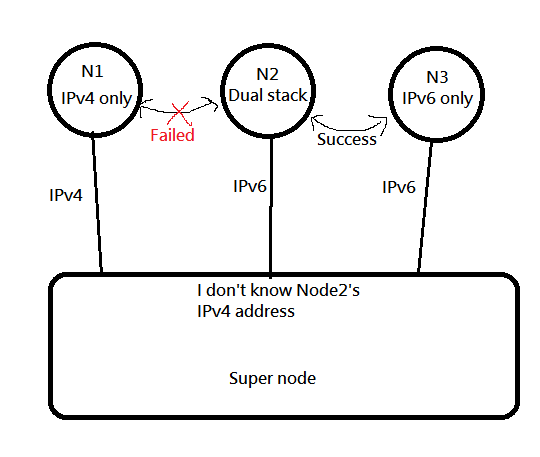
|
||
|
||
In this case, SuperNode does not know the external ipv4 address of Node02 and cannot help Node1 and Node2 to UDP hole punch.
|
||
|
||
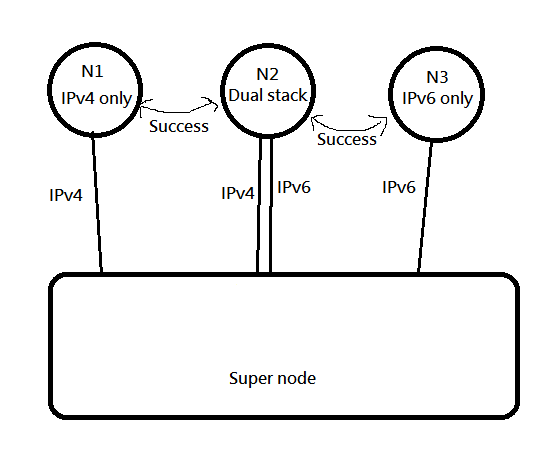
|
||
|
||
So like this, both V4 and V6 establish a session, so that both V4 and V6 can be taken care of at the same time.
|
||
|
||
## UDP hole punch reachability
|
||
For different NAT type, the UDP hole punch reachability can refer this table.([Origin](https://dh2i.com/kbs/kbs-2961448-understanding-different-nat-types-and-hole-punching/))
|
||
|
||
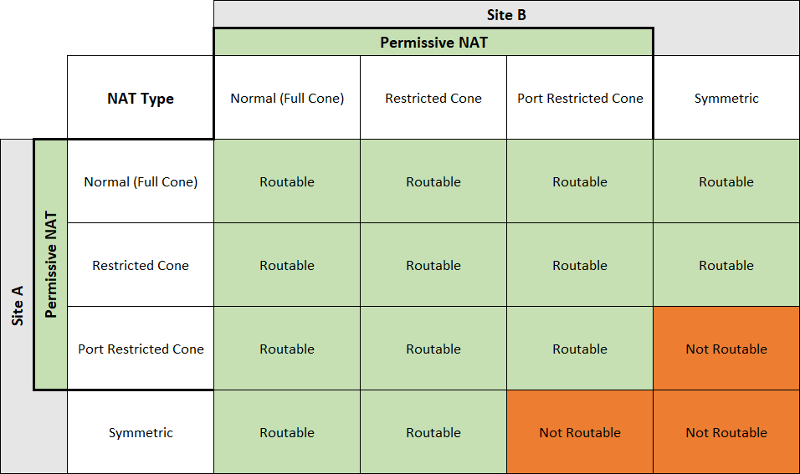
|
||
|
||
And if both sides are using ConeNAT, it's not gerenteed to punch success. It depends on the topology and the devices attributes.
|
||
Like the section 3.5 in [this article](https://bford.info/pub/net/p2pnat/#SECTION00035000000000000000), we can't punch success.
|
||
|
||
## Notice for Relay node
|
||
Unlike n2n, our supernode do not relay any packet for edges.
|
||
If the edge punch failed and no any route available, it's just unreachable. In this case we need to setup a relay node.
|
||
|
||
Relay node is a regular edge in public network, but `interface=dummy`.
|
||
|
||
And we have to note that **do not** use 127.0.0.1 to connect to supernode.
|
||
Because supernode well distribute the source IP of the nodes to all other edges. But 127.0.0.1 is not accessible from other edge.
|
||
|
||
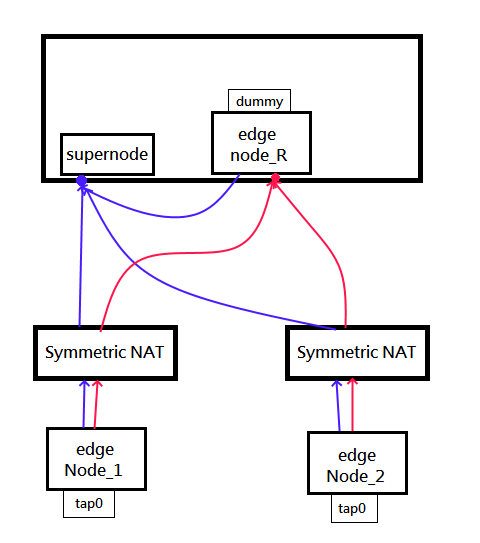
|
||
|
||
To avoid this issue, please use the external IP of the supernode in the edge config.
|
||
|
||
## Quick start
|
||
Run this example_config (please open three terminals):
|
||
```bash
|
||
./etherguard-go -config example_config/super_mode/s1.yaml -mode super
|
||
./etherguard-go -config example_config/super_mode/n1.yaml -mode edge
|
||
./etherguard-go -config example_config/super_mode/n2.yaml -mode edge
|
||
```
|
||
Because it is in `stdio` mode, stdin will be read into the VPN network
|
||
Please type in one of the edge windows
|
||
```
|
||
b1aaaaaaaaaa
|
||
```
|
||
b1 will be converted into a 12byte layer 2 header, b is the broadcast address `FF:FF:FF:FF:FF:FF`, 1 is the ordinary MAC address `AA:BB:CC:DD:EE:01`, aaaaaaaaaa is the payload, and then feed it into the VPN
|
||
You should be able to see the string b1aaaaaaaaaa on another window. The first 12 bytes are converted back
|
||
|
||
## Next: [P2P Mode](../p2p_mode/README.md) |